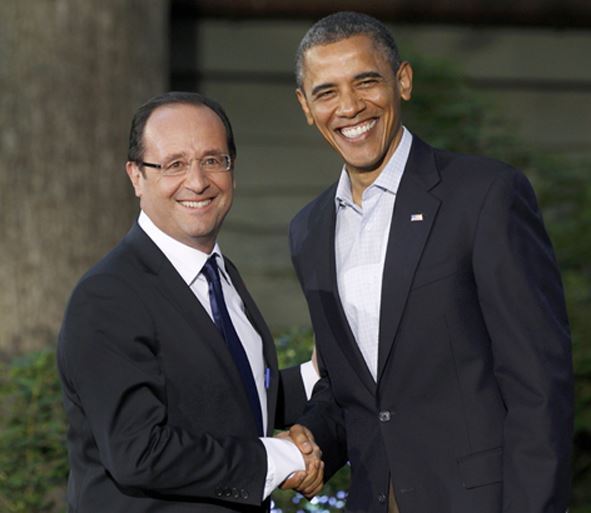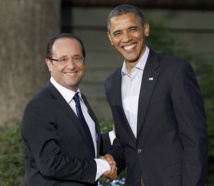Now, in Syria, Obama faces a very different problem, but many of the pressures are the same.
http://www.latimes.com/opinion/commentary/la-oe-0223-mcmanus-syria-obama-options-20140223,0,3257107.column#ixzz2u9cfZcYf
The main U.S.-backed rebel group, the Free Syrian Army, has been teetering near collapse. Other rebel forces backed by Arab countries are still in the field, but they're not winning either. Jihadist groups, some loyal to Al Qaeda, have grown stronger. And the regime of President Bashar Assad is waging a pitiless war against the rebels' civilian supporters, dropping crude "barrel bombs" of shrapnel and explosives on defenseless residential neighborhoods.
The result: more than 100,000 dead, an estimated 2.4 million refugees and a civil war that has mushroomed into a conflict affecting at least five countries.
The Obama administration's response has been limited and cautious: humanitarian aid for refugees, ineffective support for the rebels and pleas to Russia's Vladimir Putin to force Assad into diplomatic mediation.
None of it has worked. The Geneva peace conference promoted by Secretary of State John F. Kerry deadlocked after only two weeks, thanks to the Assad regime's refusal to negotiate with those it dismisses as terrorists.
Kerry and other officials have repeated their mantra that there is no military solution to the Syrian conflict. But Assad, with support from Russia and Iran, clearly believes there is.
Even the one diplomatic achievement the administration has claimed — Assad's agreement to surrender his chemical weapons — has fallen short; the regime has cannily delayed the promised shipments, knowing that as long as it holds the weapons, the U.S. has an interest in its survival.
And in one important way, the situation is now much worse: the growing strength of jihadist groups in Syria's north and east.
National Intelligence Director James Clapper warned Congress last month that the area had become "a huge concern" — a haven for extremists and a potential training ground for terrorists who might target the United States.
In other words, Syria isn't just a humanitarian crisis anymore. It's another battleground in the unfinished war against Al Qaeda and its offshoots.
That makes the case for U.S. action in Syria, if anything, stronger than it was in Libya three years ago. But there's still no appetite for it in the White House. "For the president, Iraq was the defining issue," Obama aide Ben Rhodes told the New Yorker last year. "And now Syria is viewed through that lens" — a lens of skepticism toward intervention, humanitarian or otherwise.
So the administration is taking a new look at all the other options, and already putting some of them into action.
This month, U.S. officials convened a meeting of intelligence chiefs from countries that support the rebels, including Saudi Arabia, Qatar and Turkey. The participants agreed to coordinate their aid instead of competing, as they had in the past.
The United States said it would increase its military aid, training and intelligence help for moderates among the rebels. Saudi Arabia and other participants said they would do more to crack down on the jihadists.
Saudi officials say they want to provide moderate rebel groups with shoulder-fired antiaircraft missiles to use against the Syrian aircraft that are dropping barrel bombs. Officially, the Obama administration opposes anyone supplying those missiles, for fear they could fall into the hands of terrorists and be used against civilian airliners in Israel or the West.
But administration officials said the United States may not act to block the Saudi plan. "Other countries will make their own decisions on what assistance they will provide," one official said.
One more option under discussion was an expanded U.S. training program for the rebels — run openly by the U.S. Army instead of the officially secret CIA program currently in place. But that idea appears to have stalled.
For now, the core of the Obama administration's program resembles the initial design for its intervention in Libya. The United States is convening meetings, coordinating efforts, providing intelligence — but relying on others to supply most of the direct military aid.
In other words, leading from behind.
In this case, the goal is not to topple a dictator, officials said, but to force his regime back to negotiations. But even that modest goal will be difficult to attain. Just as in Libya, Obama is likely to face more pressure to escalate if results don't come soon.
And just as in Libya, he may soon face a choice he clearly hoped to avoid: more direct forms of intervention — or else a stinging defeat with serious consequences for the United States.
doyle.mcmanus@latimes.com
Twitter: @DoyleMcManus
The result: more than 100,000 dead, an estimated 2.4 million refugees and a civil war that has mushroomed into a conflict affecting at least five countries.
The Obama administration's response has been limited and cautious: humanitarian aid for refugees, ineffective support for the rebels and pleas to Russia's Vladimir Putin to force Assad into diplomatic mediation.
None of it has worked. The Geneva peace conference promoted by Secretary of State John F. Kerry deadlocked after only two weeks, thanks to the Assad regime's refusal to negotiate with those it dismisses as terrorists.
Kerry and other officials have repeated their mantra that there is no military solution to the Syrian conflict. But Assad, with support from Russia and Iran, clearly believes there is.
Even the one diplomatic achievement the administration has claimed — Assad's agreement to surrender his chemical weapons — has fallen short; the regime has cannily delayed the promised shipments, knowing that as long as it holds the weapons, the U.S. has an interest in its survival.
And in one important way, the situation is now much worse: the growing strength of jihadist groups in Syria's north and east.
National Intelligence Director James Clapper warned Congress last month that the area had become "a huge concern" — a haven for extremists and a potential training ground for terrorists who might target the United States.
In other words, Syria isn't just a humanitarian crisis anymore. It's another battleground in the unfinished war against Al Qaeda and its offshoots.
That makes the case for U.S. action in Syria, if anything, stronger than it was in Libya three years ago. But there's still no appetite for it in the White House. "For the president, Iraq was the defining issue," Obama aide Ben Rhodes told the New Yorker last year. "And now Syria is viewed through that lens" — a lens of skepticism toward intervention, humanitarian or otherwise.
So the administration is taking a new look at all the other options, and already putting some of them into action.
This month, U.S. officials convened a meeting of intelligence chiefs from countries that support the rebels, including Saudi Arabia, Qatar and Turkey. The participants agreed to coordinate their aid instead of competing, as they had in the past.
The United States said it would increase its military aid, training and intelligence help for moderates among the rebels. Saudi Arabia and other participants said they would do more to crack down on the jihadists.
Saudi officials say they want to provide moderate rebel groups with shoulder-fired antiaircraft missiles to use against the Syrian aircraft that are dropping barrel bombs. Officially, the Obama administration opposes anyone supplying those missiles, for fear they could fall into the hands of terrorists and be used against civilian airliners in Israel or the West.
But administration officials said the United States may not act to block the Saudi plan. "Other countries will make their own decisions on what assistance they will provide," one official said.
One more option under discussion was an expanded U.S. training program for the rebels — run openly by the U.S. Army instead of the officially secret CIA program currently in place. But that idea appears to have stalled.
For now, the core of the Obama administration's program resembles the initial design for its intervention in Libya. The United States is convening meetings, coordinating efforts, providing intelligence — but relying on others to supply most of the direct military aid.
In other words, leading from behind.
In this case, the goal is not to topple a dictator, officials said, but to force his regime back to negotiations. But even that modest goal will be difficult to attain. Just as in Libya, Obama is likely to face more pressure to escalate if results don't come soon.
And just as in Libya, he may soon face a choice he clearly hoped to avoid: more direct forms of intervention — or else a stinging defeat with serious consequences for the United States.
doyle.mcmanus@latimes.com
Twitter: @DoyleMcManus
http://www.latimes.com/opinion/commentary/la-oe-0223-mcmanus-syria-obama-options-20140223,0,3257107.column#ixzz2u9cfZcYf









 Home
Home Politics
Politics











